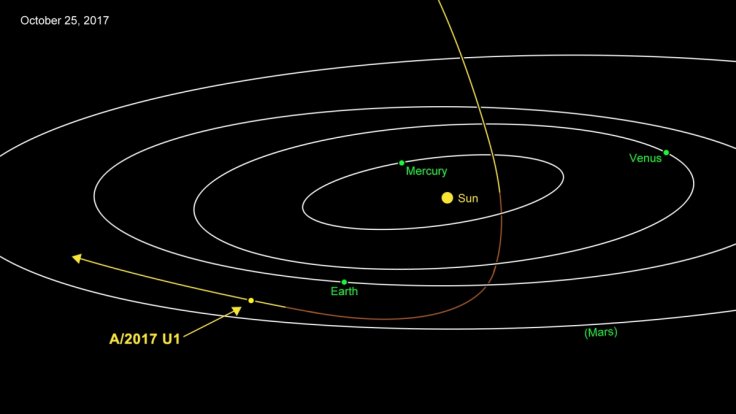
NASA believes that they have sighted the first "interstellar object" passing near the Sun through our Solar system. This object, which NASA believes as an asteroid or a comet, appeared to have originated from somewhere else in our galaxy other than our solar system.
This unusual object, which has been named A/2017 U1, was discovered on Oct. 19 using the Panoramic Survey Telescope and Rapid Response System 1 (Pan-STARRS 1) telescope of the University of Hawaii. The researchers, who were searching for near-Earth objects for NASA, had found the high-speed object which was less than a quarter-mile (400 meters) in diameter.
The astronomers are working on the data collected from telescopes around the world. They would be able to give any information about the object only after collecting and analyzing sufficient data.
Rob Weryk, a postdoctoral researcher at the University of Hawaii Institute for Astronomy (IfA), was the first person to observe the object. He submitted his observation analysis to the Minor Planet Center and searched the image archives from the Pan-STARRS. The images captured by the Pan-STARRS from the previous night also had the flying object.
Rob Weryk said, "Its motion could not be explained using either a normal solar system asteroid or comet orbit." Rob Weryk contacted Marco Micheli, an IfA graduate who had similar observations. Marco Micheli had made his observations using the European Space Agency's telescope on Tenerife in the Canary Islands. Then, Weryk said, "This object came from outside our solar system."
Davide Farnocchia, a scientist at NASA's Center for Near-Earth Object Studies (CNEOS) at the agency's Jet Propulsion Laboratory in Pasadena, California said, "This is the most extreme orbit I have ever seen. It is going extremely fast and on such a trajectory that we can say with confidence that this object is on its way out of the solar system and not coming back."
According to the graph plotted by the CNEOS from the objects current trajectory, A/2017 U1 came from the direction of the constellation Lyra and travelled through the interstellar space at a speed of 15.8 miles (25.5 Km) per second. It approached our solar system from an angle perpendicular to the ecliptic, the plane where the planets and the asteroids orbit our sun.
A/2017 U1 crossed under the ecliptic plane just inside of the Mercury's orbit on Sept. 2. It then made its closest approach to the sun on Sept. 9. The object had made a hairpin turn under our solar system due to the Sun's gravity. It had also passed under Earth orbit on Oct. 14 at a distance of about 15 million miles (24 million Km), at a distance which is 60 times the distance between Earth and Moon. A/2017 U1 has moved out of ecliptic plane and is currently moving towards the Constellation Pegasus at a speed of 27 miles (44 Km) per second.
Karen Meech, an astronomer at the IfA who is specialized in small bodies and their connection to solar system formation, said, "We have long suspected that these objects should exist because during the process of planet formation a lot of material should be ejected from planetary systems. What's most surprising is that we've never seen interstellar objects pass through before."

The Minor Planet Center (MPC), which makes all observations on small bodies in our solar system and objects passing through, named the newly discovered object as A/2017 U1. MPC Director Matt Holman said, "This kind of discovery demonstrates the great scientific value of continual wide-field surveys of the sky, coupled with intensive follow-up observations, to find things we wouldn't otherwise know are there."
The rules for naming the interstellar objects need to be formulated by the International Astronomical Union as A/2017 U1 is the first one observed by astronomers.
Paul Chodas, CNEOS Manager said, "We have been waiting for this day for decades. It's long been theorized that such objects exist – asteroids or comets moving around between the stars and occasionally passing through our solar system- but this is the first such detection. So far, everything indicates this is likely an interstellar object, but more data would help to confirm it."
David Meade, the numerologists who make doomsday predictions based on Biblical quotes, had earlier predicted the start of the world's end on Oct. 15, when mythical planet Nibiru, or Planet X supposedly came close to the earth. However, NASA had not acknowledged the existence of a planet which is similar to Nibiru.
NASA had recently stated that a mysterious ninth planet exists in the solar system, which could change the orbit and axis of planets as well as change directions of asteroids in the Kuiper belt.









